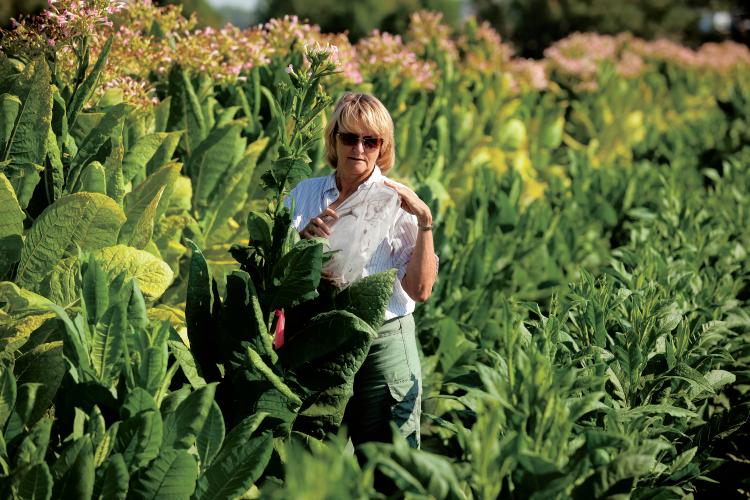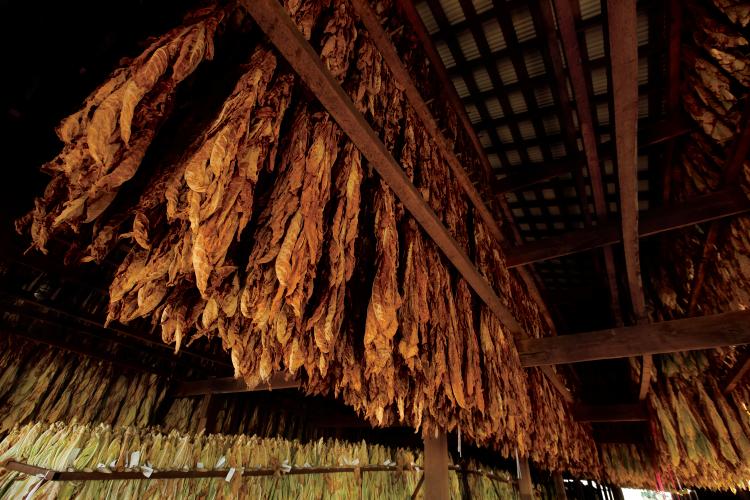Home > Kentucky > Kentucky Crops & Livestock > Kentucky Tobacco Producers Adapt to a Changing Industry
Kentucky Tobacco Producers Adapt to a Changing Industry

Making jet fuel from tobacco is a technology under study at the Kentucky Tobacco Research & Development Center in Lexington, in partnership with the Lawrence Berkeley National Laboratory and the University of California, Berkeley.
“It involves the engineering of tobacco to produce hydrocarbons for a variety of potential biofuels applications, including jet fuel,” says Orlando Chambers, Kentucky Tobacco Research and Development Center managing director. “Other efforts being studied within the industry these days include using tobacco in the production of flu vaccines, and a rabies vaccine from tobacco is being researched for a medical group in South Africa.”
Chambers says several other technologies are currently being developed.
“New uses for tobacco are being found in the areas of pharmaceuticals, as well as in the production of industrial chemicals and materials,” he says. “From a biotech standpoint, tobacco is very easy to engineer, produces a large amount of biomass and because it is not a food or feed crop, so many research angles can be taken to manufacture new materials.”
The research center is also looking into ways to better help Kentucky farmers who still grow the crop for their livelihood, and will face even more federal regulations in the near future.
Specifically, the U.S. Food and Drug Administration has developed a list of 93 substances found in tobacco leaves and may soon set levels for the amount of each substance that can be present in future tobacco products.
“We will try to develop new types of tobacco to be grown in the future, based on the FDA’s regulation of the crop,” Chambers says. “We already have an analytical laboratory facility set up to help address that issue.”

Consolidation of Farms
For decades, tobacco was king of all crops in Kentucky. But in 2004, when the Fair and Equitable Tobacco Reform Act – commonly known as the Tobacco Buyout – was instituted by the U.S. Department of Agriculture, many tobacco farmers turned to other crops. Several tobacco operations in the state accepted monetary buyouts as a result of the act, which did not prevent anyone from producing tobacco in the future. And while a lot of tobacco farms now support different agriculture, Kentucky remains a formidable tobacco-producing state.
“The consolidation of small farms into fewer, larger farms is what makes up much of the industry’s economics today in our state,” says Will Snell, agricultural economist at the University of Kentucky. “Twenty years ago, there were 60,000 farms in Kentucky raising tobacco, and today there are 5,000-6,000, with the average tobacco farm in Kentucky now being close to 20 acres.”

More Export Sales than Domestic
Snell says tobacco has historically accounted for about 25 percent of Kentucky’s total agricultural sales, but today the industry comprises less than 10 percent of such sales.
“The state’s most profitable year for tobacco was 1998, when $924 million of the crop was sold, compared to around $300 million to $350 million in sales in recent years,” he says. “A big chunk of that $300 million nowadays comes from export sales. Past years saw tobacco sales at 75 percent domestic and 25 percent from exports, but now it’s the opposite with two-thirds to three-fourths of our leaf being exported. Japan and Western Europe are currently the biggest buyers of Kentucky tobacco.”
Two kinds of tobacco still grow well in Kentucky: Dark tobacco produced in the western third of the state, and burley tobacco grown primarily in the central and Bluegrass regions of Kentucky.
“Historically, burley represented more than 90 percent of our grown tobacco when cigarettes were at their peak, but today burley accounts for only 70 percent of the overall market value, compared to 30 percent dark tobacco,” Snell says. “Smokeless products are made from dark tobacco, and that sector has been increasing in popularity over the last couple of decades, while cigarette production has seen a decline.”

Upcoming Challenges
Snell adds that key challenges for the tobacco industry in future years are finding an adequate and affordable labor supply, and future regulations that will impact growers. Unlike other crops, tobacco producers have found it difficult to adopt profitable forms of mechanization.
“It is still a labor-dependent industry that relies on a migrant workforce that has become increasingly difficult to hire in these days of growing labor regulations and the debate over immigration reform,” he says. “Bottom line is that long-term uncertainties face tobacco’s future, whether it is FDA regulations or rising labor costs. These uncertainties have been limiting Kentucky farmers from reinvesting heavily in the industry – at least for the time being.”
Despite these hurdles, a significant number of Kentucky farmers still consider tobacco to be a profitable mix in their enterprise selection.



